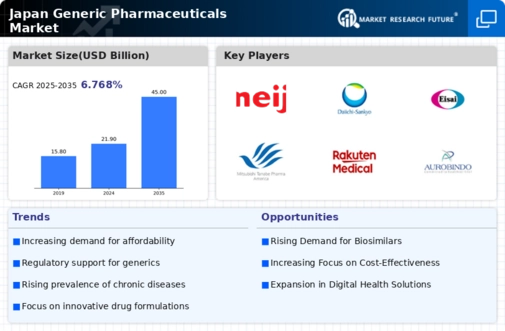The competitive dynamics within the generic pharmaceuticals market in Japan are characterized by a blend of innovation, strategic partnerships, and regional expansion. Key players such as Teva Pharmaceutical Industries (IL), Sandoz (CH), and Mylan (US) are actively shaping the landscape through their distinct operational focuses. Teva, for instance, emphasizes a robust pipeline of generic products, aiming to enhance its market share through continuous innovation and strategic collaborations. Sandoz, a division of Novartis, appears to be concentrating on expanding its biosimilars portfolio, which could potentially redefine its competitive edge. Mylan, on the other hand, is likely leveraging its extensive distribution network to penetrate deeper into the Japanese market, thereby enhancing accessibility to its generic offerings.
The market structure is moderately fragmented, with several players vying for dominance. Key business tactics such as localizing manufacturing and optimizing supply chains are prevalent among these companies. This localized approach not only reduces operational costs but also enhances responsiveness to market demands. The collective influence of these major players contributes to a competitive environment where agility and adaptability are paramount.
In October 2025, Teva Pharmaceutical Industries (IL) announced a strategic partnership with a local Japanese biotech firm to co-develop a new line of generic biologics. This collaboration is significant as it not only strengthens Teva's position in the biologics segment but also aligns with Japan's increasing focus on innovative therapies. Such partnerships may enhance Teva's ability to navigate regulatory landscapes while tapping into local expertise.
In September 2025, Sandoz (CH) launched a new generic version of a widely used cardiovascular medication in Japan, which is expected to capture a substantial market share. This move underscores Sandoz's commitment to addressing critical healthcare needs while reinforcing its competitive stance against other generics. The introduction of this product may also reflect a broader trend towards increasing access to essential medications in the region.
In August 2025, Mylan (US) expanded its manufacturing capabilities in Japan by investing in a new facility aimed at producing high-demand generics. This strategic investment is likely to enhance Mylan's production efficiency and supply chain reliability, positioning the company favorably in a market that increasingly values local production. Such expansions may also indicate a shift towards more sustainable practices in the industry.
As of November 2025, current trends in the generic pharmaceuticals market are increasingly defined by digitalization, sustainability, and the integration of artificial intelligence. Strategic alliances are becoming more prevalent, as companies recognize the need to collaborate to enhance innovation and operational efficiency. The competitive landscape is evolving, with a noticeable shift from traditional price-based competition towards differentiation through technology, innovation, and supply chain reliability. This evolution suggests that companies that can effectively leverage these trends will likely secure a competitive advantage in the future.





















Leave a Comment